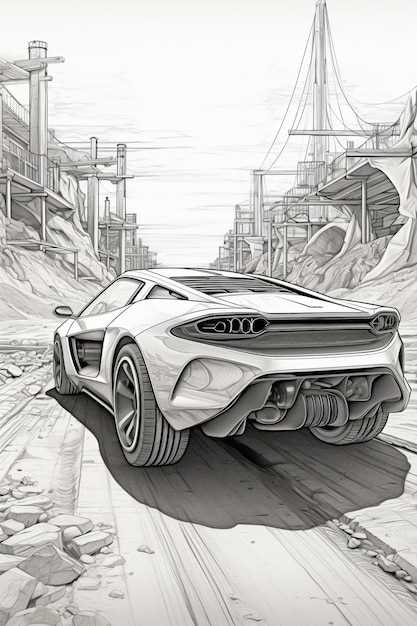
The Ford Mustang, introduced in 1964, has become a symbol of American automotive culture, particularly in the realm of muscle cars. This iconic vehicle not only set the stage for a new class of automobiles but also established key design principles that continue to shape the muscle car segment. The Mustang’s blend of aggressive styling, powerful performance, and accessibility transformed consumer expectations and led to a surge in interest for high-performance vehicles.
One of the defining elements of the Mustang’s influence on muscle car design is its emphasis on a strong aesthetic appeal combined with raw power. Manufacturers quickly recognized that a visually striking design could attract buyers, while the robust engines catered to enthusiasts seeking speed and performance. The Mustang’s success inspired other automotive brands to innovate, leading to the creation of numerous competitors in the muscle car market, each aiming to capture the same spirited essence.
Additionally, the Mustang’s versatility became a blueprint for muscle car design. With a range of models–from the base models to high-performance variants like the Shelby GT350–Ford demonstrated that muscle cars could cater to diverse customer preferences. This adaptability reinforced the notion that a muscle car does not have to sacrifice comfort or style for power, encouraging other manufacturers to explore similar strategies in their designs.
Key Design Features Inspired by the Mustang

The Ford Mustang revolutionized the muscle car segment with its distinct design features that continue to influence manufacturers today. One of the hallmark traits is the long hood and short rear deck silhouette, offering a sporty yet aggressive stance. This design not only enhances aerodynamics but also provides a classic aesthetic that many muscle cars emulate.
Another key feature is the prominent grille, which often includes a bold emblem at its center. This characteristic grille design not only serves a functional purpose in cooling the engine but also ensures instant recognition and a commanding presence on the road. Many modern muscle cars have adopted similar grille styles, creating a visual link to the Mustang lineage.
The Mustang popularized the use of wide wheel arches, which accommodate larger tires and give the car a more muscular appearance. This aspect improves both grip and handling, making it an essential design principle replicated across various muscle car models to enhance performance while maintaining aggressive styling.
Merging retro aesthetics with modern technology, the Mustang features sleek, aggressive lighting designs, such as LED headlamps and taillights. This forward-thinking approach not only adds to the visual appeal but also improves visibility and safety. Other muscle cars often incorporate similar lighting features to enhance their overall look while staying competitive.
Finally, the interior of the Mustang emphasizes driver-centric design with ergonomic layouts and sporty instrumentation. This focus on the driving experience has inspired manufacturers to create interiors that prioritize comfort and usability, ensuring that the muscle car ethos extends beyond the exterior.
Performance Metrics Shaped by Mustang Engineering
The Ford Mustang was introduced in 1964, setting a new standard in the automotive industry, particularly in the realm of muscle cars. Its engineering principles focused on delivering remarkable performance metrics that have influenced countless other car designs since.
One of the most significant aspects of Mustang engineering is its power-to-weight ratio. The Mustang was designed to be lightweight while housing powerful engines, allowing for quick acceleration and improved handling. This balance became a crucial element in the development of future muscle cars, encouraging manufacturers to test the limits of their designs.
Another vital performance metric is the braking capabilities. The Mustang’s engineering included advanced braking systems, which provided superior stopping power and stability at high speeds. The incorporation of disc brakes set the benchmark for other car manufacturers striving to achieve similar performance levels in their muscle car models.
Additionally, Mustang engineering emphasized suspension systems that offered better road grip and agility. Innovations such as the MacPherson strut front suspension helped to enhance the driving experience, influencing the suspension designs in many subsequent muscle cars. This focus on handling characteristics allowed drivers to experience a more connected and responsive ride.
The Mustang also pioneered the inclusion of various engine options, catering to a wide range of consumer preferences. This approach led to the development of high-performance variations that became iconic, shaping how other car manufacturers approached engine diversity and performance tuning in their muscle cars.
In conclusion, the performance metrics established by Mustang engineering have become fundamental principles in muscle car design. From power-to-weight ratio to braking and suspension systems, the Mustang has left an indelible mark on the automotive world, guiding future designs toward enhanced performance and driver satisfaction.
Cultural Impact of the Mustang on Muscle Car Aesthetics

The Ford Mustang, introduced in 1964, significantly influenced the aesthetics of muscle cars, combining performance with style. Its design featured a long hood and short rear deck, a hallmark that became iconic in the muscle car genre. This visual signature, characterized by bold lines and aggressive stances, set a standard that other manufacturers emulated.
Moreover, the Mustang’s design elements, such as the prominent grille and sporty silhouette, helped define a new automotive culture. The emergence of this “pony car” not only inspired competition among major automotive brands but also captivated the imagination of car enthusiasts and the general public alike. The Mustang symbolized freedom and youth, cementing its place in popular culture through films, music, and art.
The Mustang’s aesthetic appeal extended beyond its physical attributes; it represented a lifestyle and an attitude. This cultural significance shaped the marketing of muscle cars throughout the 1960s and beyond, driving a surge in personal expression through car ownership. The result was a diverse range of models that embraced the Mustang’s spirit while incorporating unique designs that resonated with different audiences.
In conclusion, the Ford Mustang’s impact on muscle car aesthetics is profound. Its design principles and cultural representation have left an indelible mark on the automotive world, influencing generations of cars and their enthusiasts. The Mustang remains a benchmark for style and performance, showcasing how design can transcend mere functionality to represent broader cultural themes.



